Real estate market segment: Middle income
Current trends
Due to a variety of economic and social factors, the main focus for the middle income segment is in the arena of newly built houses and plots of land. This segment of the market tends to diverge into the suburbs of Colombo city, opting for larger properties 20-30 km 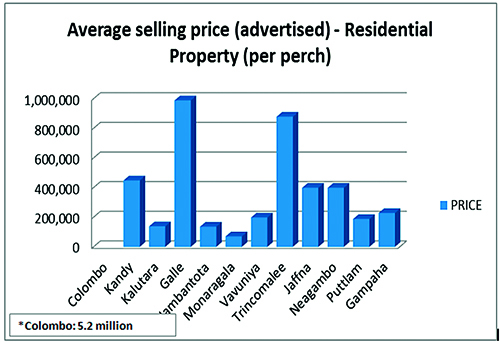 away from the city. The fastest growing segment in terms of deal closure in the real estate market is associated with the middle income earners in Sri Lanka.
away from the city. The fastest growing segment in terms of deal closure in the real estate market is associated with the middle income earners in Sri Lanka.
The middle income segment is heavily dependent on interest rates and the domestic economy. Unemployment rates, inflation rates and interest rates have direct consequences on this market segment. Their ability to be provided with loan facilities from banks has expanded in recent years and therefore has resulted in an expansion of affordable housing options, in Colombo as well as in the suburbs. This is consistent with increases in public housing initiatives, falling unemployment rates and increases in foreign remittances.
Cultural and societal trends that are also leading to increased demand for home loans and wider home ownership in Sri Lanka, especially amongst young newly married couples who are increasingly looking to own their own home as compared with the option of living with their parents. The middle income segment consists mainly of first time buyers, young couples,  and families. Studies indicate that the market has grown at a compound rate with the escalation of per capita income and changing patterns of consumption and saving habits in the recent past.
and families. Studies indicate that the market has grown at a compound rate with the escalation of per capita income and changing patterns of consumption and saving habits in the recent past.
Government data indicate that the urban population is about 30 per cent. Nationwide, close to 90 percent of the housing units are owner occupied. Sri Lanka’s small rental market – only 5.4 per cent of the total housing stock – is dominated by high-end luxury apartments. The market for middle- and low-income renters is almost non-existent. There’s now a severe housing shortage, which could reach 650,000 units by the end of the year, in a country of around five million households, according to the Ministry of Housing and Plantation Infrastructure.
The demand for house rehabilitation and upkeep is met in a limited manner currently. The country has embarked on a gradual  transition from a system of directed credit in a highly segmented market toward an integrated, market-driven housing finance system. Nurturing home mortgage markets requires a stable macro-economy, low inflation, and careful fiscal policies. The share of state-owned housing institutions—such as the State Mortgage and Investment Bank (SMIB), the Housing Development Finance Corporation (HDFC), and the National Savings Bank (NSB)—has come down to about one third of the mortgage market share, as the private sector has displaced the government as the primary housing finance provider.
transition from a system of directed credit in a highly segmented market toward an integrated, market-driven housing finance system. Nurturing home mortgage markets requires a stable macro-economy, low inflation, and careful fiscal policies. The share of state-owned housing institutions—such as the State Mortgage and Investment Bank (SMIB), the Housing Development Finance Corporation (HDFC), and the National Savings Bank (NSB)—has come down to about one third of the mortgage market share, as the private sector has displaced the government as the primary housing finance provider.
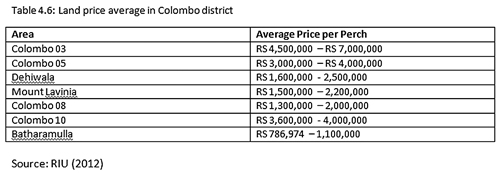 Trends in the land market
Trends in the land market
In the post-war scenario, interest in land purchases has increased significantly according to sources operating in the industry. Areas like Kandy, Galle and Hambantota are showing evidence of growth, especially with the nearing of completion of the  Southern highway for the latter two cities. The land market in the Western Province areas like Colombo, Kalutara and Gampaha have been comparatively slow yet steady, with only a marginal peace-dividend impact.
Southern highway for the latter two cities. The land market in the Western Province areas like Colombo, Kalutara and Gampaha have been comparatively slow yet steady, with only a marginal peace-dividend impact.
All foreign acquisition of land is taxed at 100 per cent in Sri Lanka. All land purchases must be registered with the Registrar of Lands along with the ‘Deed of Transfer’. Stamp Duty tax will be applicable on this, depending on the value of the land. There are no taxes on capital gains with regard to property values. The table above provides some indicative land prices for Colombo city and suburban areas based on current advertised rates.
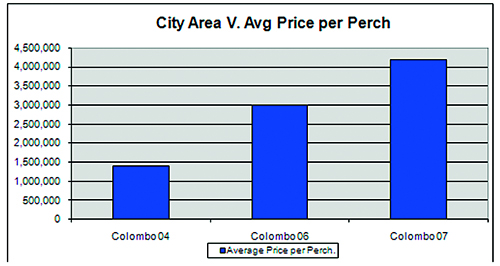 |
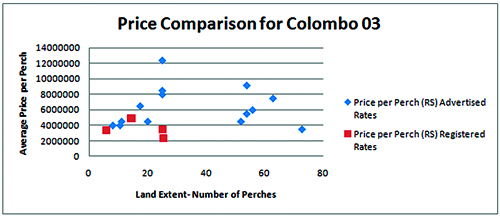 |
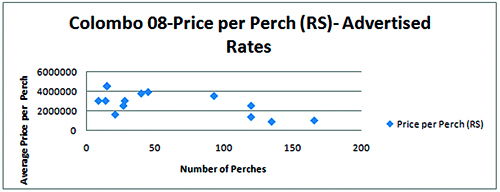 |


